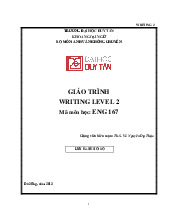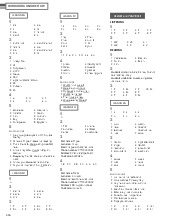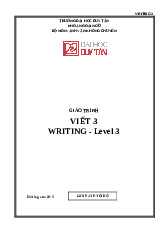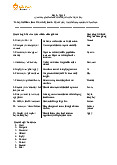





Preview text:
3. is also called nosebleed.
A. Cyanosis B. Hoarseness C. Retraction D. Epistaxis
8. This is a medical term for protrusion of the eyeballs: A. exophthalmos B. amenorrhea C. polydipsia D. sluggishness
2. The process of combining the sperm with the ovum is called: A. fermentation B. gestation
C. menstruation D. fertilization
3. Birth control pill and IUD do not protect a woman _______ sexually transmitted disease or HIV infection. A. during B. either C. against D. between
4. _______ is the implantation of the fertilized egg in any site other than the normal uterine location. A. Abruptio placentae B. Multiple gestations C. Placenta previa D. Ectopic pregnancy
6. The area between the anus and the vagina in females is called: A. perineum B. epididymis C. clitoris D. scrotum
7. ______ includes the perineum, labia and clitoris, and hymen. A. vulva B. vagina C. coitus D. cervix
8. This is the medical term for the surgical removal of the uterus: A. mastectomy B. vasectomy C. episiotomy D. hysterectomy
9. A blood vessel-rich organ implanting in the uterine to nourish the embryo is called: A. chorion B. amnion C. placenta D. umbilicus
3. A simple, rapid, automatic response to a stimulus is a(n): A. nerve B. axon C. sense D. reflex
5. _______ nerves carry impulses to the brain and spinal cord from stimulus receptors. A. Autonomic B. Afferent C. Efferent D. Cranial
9. Cerebrospinal fluid is formed within the _______ and circulates between the membranes
around the brain and within the spinal cord. A. ventricles B. cerebrum C. dendrite D. brainstem
1. _________ is what we need to do first in out-of-hospital emergency cases. A. Moving the victim
B. Asking the victim’s information C. Calling for help D. Waking the victim up
2. _______ diseases are the diseases that exist at or date from birth. A. Malignant B. Traumatic C. Congenital D. Intermittent
3. A prediction of the probable course and outcome of a disease, especially of the chances of recovery is called: A. prophylaxis B. prognosis C. diagnosis D. consultation
5. The study and analysis of the distribution and determinants of health and disease
conditions in defined populations is called: A. epidemiology B. etiology C. physiology D. pathology
6. In many hospitals, code blue means: A. bomb threat B. external disaster C. hostage taking D. cardiac arrest
7. _______ refers to the loss of differentiation of cells and reversion to a more primitive cell type. A. anaplasia B. invasive C. infiltrative D. metastasis
8. _______ means spreading to a secondary site. A. anaplasia B. invasive C. infiltrative D. metastasis
9. Chemotherapy for ovarian cancer causes loss of hair on the head, or: A. Fibrosis B. Alopecia C. Infertility D. Mucositis
10. ______ tumors are capable of invasion and spread to surrounding or more distant sites. A. malignant B. benign
1. _______ is a subspecialty of internal medicine. A. Nephrology B. Trauma C. Urology D. Otolaryngology
4. The aim of Pediatrics is to minimize the adverse effects of disease, while allowing
children to live ________ possible. A. as a normal life B. as normal as a life C. as normal a life as D. a life as normal
1. _______ age of a fetus is measured in weeks from the first day of the mother’s last menstrual period. A. Umbilical B. Gestational C. Congenital D. Placental
2. _______ surgical procedures are performed when a patient’s condition is not
immediately life- threatening, but failure to treat it may result in death. A. Elective B. Emergency C. Urgent D. Required
3. These are some common emergencies in Obstetrics, except for: A. Shoulder dystocia B. Pre-eclampsia C. Cerebral contusion D. Uterine rupture
4. This is a technique used to monitor the fetal heartbeat and the uterine contractions during pregnancy and labour: A. Electrocardiogram B. Electroencephalogram C. Cardiotocography D. Electromyography
6. My uncle is going to _______ an operation because he has appendicitis. A. undergoes B. performs C. perform D. undergo



